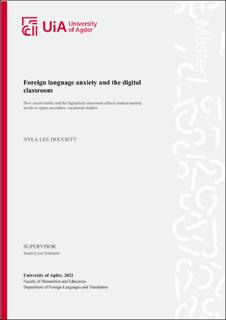| dc.description.abstract | This thesis examines foreign language anxiety’s impact on upper secondary vocational students in Norwegian schools. This study is a continuation of previous research on foreign language anxiety and attempts to offer new insight into how social media and the digital classroom may affect student anxiety levels. The study examined twenty-eight students in two different classes and consisted of a questionnaire, eleven interviews, and responses to Horwitz et al. (1986) Foreign Language Classroom Anxiety Scale (FLCAS). The thesis attempts to use these three investigatory modes to understand how the modern, digitally saturated classroom impacts student anxiety.
This study aims to answer three research questions focusing on students’ comfort levels when speaking English in the classroom. The 12th of March, 2021, marked the beginning of the national lockdown of schools in Norway, leading to online lectures and homeschooling. This development led to a massive and unprecedented digitalisation of education and raised issues of student safety, anxiety levels, responsibilities, and rights. The move to Zoom as a mass education tool took place out of necessity, but without a solid research history investigating its impact on students below the tertiary level. While this study does not offer a comprehensive investigation into the impact of Zoom and does not focus exclusively on digital education platforms, it does attempt to offer some insight into how students experienced Zoom in the language classroom and how they experience the other range of internet-connected devices in their educational settings.
This study found that few students are worried about being recorded or filmed during class, however, those even those who are worried about being filmed are reluctant to require the removal mobile phones and computers from the classroom. Further, while most of the students participating in the study experienced medium to high anxiety levels linked to at least some areas of foreign language learning and usage, many of these students experienced anxiety in other subjects as well. Regarding anxiety outside the classroom, students felt more secure when speaking English to natives in a natural setting, such as on holiday or online with friends, than they did in the classroom.
The study contributes to research on language anxiety in the Norwegian context. Further, it provides teachers, and potentially students, with helpful insight into the importance of awareness surrounding foreign language anxiety and its effects on language acquisition. The study also offers new insight into the discussion regarding “black screens and anxiety” on Zoom and provides a picture of how students experience the modern, digitally-linked classroom.
Key words: foreign language anxiety, zoom, digital classroom, vocational studies, FLCAS, Krashen, social media | |
